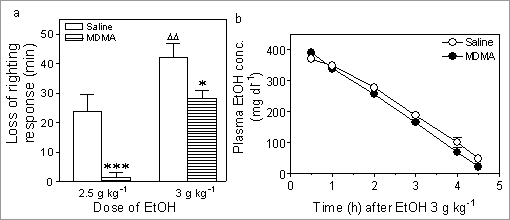Print version
Search Pub Med
Evidence that a neurotoxic dose of MDMAreduces ethanol-induced sedation and rapid tolerance development to hypothermia in mice
Mice administered a neurotoxic dose of 3,4-methylenedioxymethamphetamine (MDMA, ‘ecstasy’) which produced a major loss of striatal dopamine (DA) content exhibited a higher consumption of and preference for ethanol (EtOH) compared with saline-treated animals (Marchant et al., 2005, this meeting). We have now examined whether these mice are less sensitive to the sedative-hypnotic effect of acute EtOH and/or exhibit alterations in the development of rapid tolerance to the hypothermic effect of EtOH. Metabolism of EtOH was also evaluated. Adult male C57BL/6J mice (25-30 g) were injected with saline (controls) or MDMA (30 mg kg-1, i.p. x 3, 3h intervals) 7d before starting EtOH studies. To induce sedation, mice received EtOH (2.5 and 3 g kg-1, i.p., 20% w/v) and the time to regain the righting reflex measured. Rapid tolerance to EtOH (3 g kg-1)-induced hypothermia after repeated injection over 2d was also evaluated. Plasma EtOH levels were determined for 4.5h after injection of EtOH (3 g kg-1) to both groups. Animals were killed at the end of the EtOH study and striatal DA levels determined by h.p.l.c. MDMA-pretreated animals regained the righting reflex significantly sooner following both doses of EtOH (Figure 1a). EtOH markedly reduced rectal temperature in MDMA and saline-pretreated mice for at least 3h. Hypothermia was less pronounced in saline-pretreated animals which had received EtOH 24h before (rapid tolerance). However, in MDMA-pretreated mice there was no difference between changes induced by the 1st and 2nd EtOH administration. Plasma EtOH concentrations 4.5h after EtOH administration did not differ between both groups (Figure 1b). MDMA-pretreatment decreased striatal DA by 60%. These findings indicate that a long-lasting loss of DA concentration induced by MDMA administration makes mice less sensitive to EtOH-induced sedative/hypnotic effects and resistant to the development of rapid tolerance to hypothermia.
Figure 1. EtOH-induced loss of righting response (a) and EtOH metabolism (b) in mice exposed to MDMA or saline 7 days before. Results shown as mean ± s.e.mean, n= 5-8. Different from the corresponding saline-pretreated mice: *P<0.05, ***P<0.001. Different from EtOH 2.5 g kg-1 in saline-pretreated mice: ΔΔP <0.01 (Newman-Keuls). M.I.C. thanks PNSD (MSC), MCYT ( SAF2004-02603) and FIS ( G03/005) for support. * Permanent address: F. Medicina, U. Valparaíso, Hontaneda 2653, Valparaíso, Chile. |


